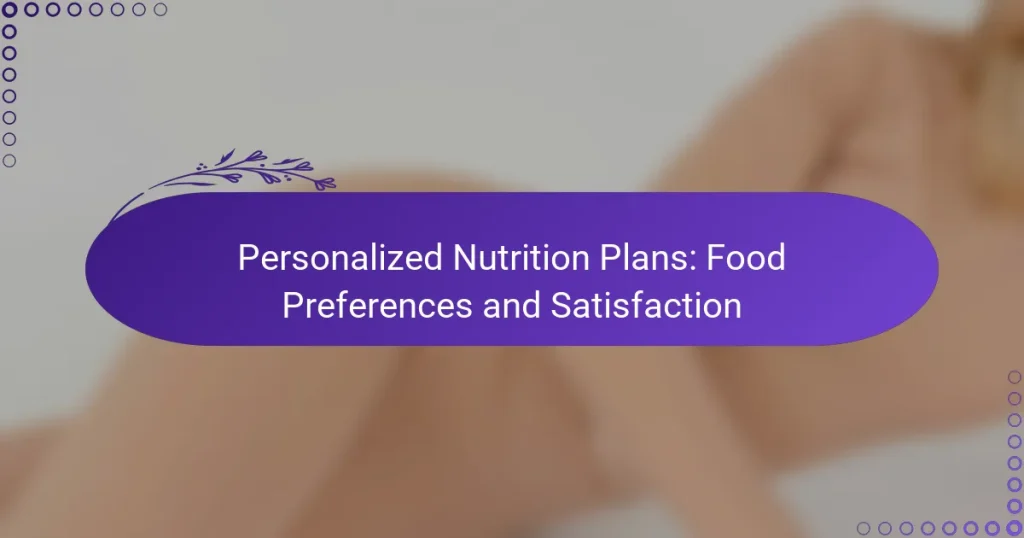Personalized nutrition plans are designed to enhance food satisfaction by aligning dietary choices with individual tastes and preferences. By considering factors such as health conditions, cultural background, and personal taste profiles, these plans create a more enjoyable and fulfilling eating experience, ultimately leading to better adherence and improved health outcomes.

How can personalized nutrition plans improve food satisfaction?
Personalized nutrition plans can significantly enhance food satisfaction by aligning dietary choices with individual tastes and preferences. By focusing on what people enjoy eating, these plans foster a more enjoyable and fulfilling eating experience.
Enhanced taste preferences
Personalized nutrition plans take into account individual taste preferences, allowing for meals that cater to specific likes and dislikes. This customization can lead to a greater appreciation of food, as meals become more aligned with personal flavor profiles.
For example, if someone prefers spicy foods, a personalized plan can incorporate more herbs and spices, making meals more enjoyable. This tailored approach can also help individuals explore new ingredients that fit their taste, broadening their culinary horizons.
Increased meal enjoyment
When meals are tailored to personal preferences, overall meal enjoyment tends to increase. Enjoyable meals can lead to a more positive eating experience, which is crucial for maintaining a healthy diet.
Incorporating favorite foods and flavors can transform mealtime from a chore into a pleasurable activity. For instance, someone who loves Italian cuisine might enjoy a personalized plan featuring whole grain pasta with fresh vegetables and lean proteins, enhancing both satisfaction and nutrition.
Better adherence to dietary goals
Personalized nutrition plans not only improve food satisfaction but also promote better adherence to dietary goals. When individuals enjoy their meals, they are more likely to stick to their nutritional guidelines and make healthier choices.
To ensure adherence, it’s essential to balance enjoyment with nutritional needs. For example, a plan that includes favorite snacks in moderation can help individuals feel satisfied while still meeting their dietary objectives. Avoiding overly restrictive diets is key to long-term success and satisfaction.

What factors influence food preferences in personalized nutrition?
Food preferences in personalized nutrition are shaped by a variety of factors, including individual health conditions, cultural background, and personal taste profiles. Understanding these influences can help tailor nutrition plans that enhance satisfaction and adherence.
Individual health conditions
Health conditions significantly impact food preferences and dietary choices. For instance, individuals with diabetes may prefer low-glycemic foods, while those with lactose intolerance will avoid dairy products. It’s essential to consider these conditions when creating a personalized nutrition plan to ensure it aligns with health needs.
Consulting with healthcare professionals can provide insights into specific dietary restrictions or recommendations based on medical history. This approach helps in selecting foods that not only meet nutritional goals but also support overall health.
Cultural background
Cultural background plays a crucial role in shaping food preferences. Traditional cuisines often dictate the types of flavors, ingredients, and cooking methods individuals are accustomed to. For example, Mediterranean diets emphasize olive oil and fresh vegetables, while Asian cuisines may focus on rice and seafood.
Incorporating culturally relevant foods into personalized nutrition plans can enhance satisfaction and adherence. Understanding cultural significance and food rituals can also foster a deeper connection to the diet, making it more enjoyable and sustainable.
Personal taste profiles
Personal taste profiles, which include preferences for sweetness, saltiness, bitterness, and umami, are vital in determining food choices. Individuals may have strong likes or dislikes that influence their willingness to try new foods or adhere to a nutrition plan. For example, someone who enjoys spicy foods may be more inclined to include peppers and seasonings in their meals.
To create a satisfying personalized nutrition plan, it’s important to assess these taste preferences. Experimenting with different flavors and cooking techniques can help individuals discover new foods they enjoy while still meeting their nutritional needs.

How to create a personalized nutrition plan?
Creating a personalized nutrition plan involves assessing individual dietary needs, incorporating food preferences, and utilizing tracking tools to ensure satisfaction and adherence. This tailored approach helps optimize health outcomes and enhances the overall eating experience.
Assess dietary needs
To develop an effective nutrition plan, start by evaluating your dietary needs based on factors like age, gender, activity level, and health goals. Consider consulting a healthcare professional or a registered dietitian for a comprehensive assessment.
Identify specific nutritional requirements, such as macronutrient ratios (carbohydrates, proteins, fats) and micronutrient needs (vitamins and minerals). For example, an active individual might require higher protein intake compared to someone with a sedentary lifestyle.
Incorporate food preferences
Incorporating personal food preferences is crucial for long-term adherence to a nutrition plan. Take note of your favorite foods, dietary restrictions, and cultural influences to create a satisfying meal plan.
For instance, if you enjoy Mediterranean cuisine, include foods like olive oil, fish, and whole grains while ensuring they align with your dietary needs. This approach not only enhances enjoyment but also promotes a sustainable eating pattern.
Utilize nutrition tracking tools
Nutrition tracking tools can help monitor food intake and ensure compliance with your personalized nutrition plan. Consider using apps or online platforms that allow you to log meals, track macronutrients, and set goals.
Choose a tool that fits your lifestyle and preferences, whether it’s a mobile app like MyFitnessPal or a simple food diary. Regularly reviewing your progress can help identify areas for improvement and keep you motivated.

What are the benefits of using technology in personalized nutrition?
Using technology in personalized nutrition enhances dietary choices through tailored recommendations based on individual preferences and health data. This approach not only improves satisfaction with food options but also promotes better adherence to nutritional goals.
Real-time dietary adjustments
Technology enables real-time dietary adjustments by analyzing data from users’ food intake and health metrics. For instance, apps can suggest meal modifications based on current blood sugar levels or activity levels, ensuring that users stay aligned with their nutritional objectives.
These adjustments can be as simple as recommending a lower-carb meal after detecting high glucose levels or suggesting additional protein intake following an intense workout. This dynamic approach helps users make informed choices that suit their immediate needs.
Data-driven insights
Data-driven insights derived from technology provide users with a comprehensive understanding of their eating habits. By tracking consumption patterns, users can identify trends, such as frequent cravings for certain foods or times of day when they tend to overeat.
For example, a user might discover that they consume more calories on weekends. Armed with this knowledge, they can implement strategies to manage their intake, such as planning healthier snacks or pre-logging meals to stay within their caloric goals.
Enhanced user engagement
Technology fosters enhanced user engagement through interactive features and personalized feedback. Many nutrition apps include gamification elements, such as challenges or rewards for meeting dietary goals, which can motivate users to stick to their plans.
Additionally, personalized notifications and reminders can keep users accountable. For instance, receiving a reminder to drink water or eat a balanced meal can help reinforce healthy habits and maintain focus on their nutrition journey.

Which tools can help with personalized nutrition planning?
Several tools can assist with personalized nutrition planning by allowing users to track their food preferences and satisfaction. These platforms typically offer features for meal tracking, recipe suggestions, and nutritional analysis tailored to individual dietary needs.
MyFitnessPal
MyFitnessPal is a widely used app that helps users log their meals and track nutritional intake. It features a vast database of foods, making it easy to find and record meals, while also allowing users to set personal goals based on their dietary preferences.
The app offers a community aspect, where users can connect with others for motivation and support. Additionally, it provides insights into macronutrient distribution, helping users adjust their eating habits to meet specific health goals.
Nutrium
Nutrium is designed for both consumers and nutrition professionals, facilitating personalized meal planning and dietary tracking. Users can receive tailored meal suggestions based on their preferences and nutritional requirements, making it easier to stick to a personalized plan.
One unique feature of Nutrium is its ability to allow nutritionists to create and share meal plans directly with clients. This can enhance accountability and ensure that the meal plans align with the client’s health objectives.
Eat This Much
Eat This Much focuses on automated meal planning based on user-defined dietary preferences and goals. Users can input their food likes, dislikes, and nutritional targets, and the app generates meal plans that fit these criteria.
This tool is particularly useful for those who struggle with meal prep, as it provides grocery lists and portion sizes, streamlining the shopping process. Users can also adjust their plans easily if they want to try new foods or recipes, promoting variety in their diet.

How do local food options affect personalized nutrition?
Local food options significantly influence personalized nutrition by determining the availability and variety of ingredients that can be tailored to individual dietary needs and preferences. Access to diverse and fresh food sources can enhance meal satisfaction and nutritional quality.
Availability of fresh produce
The availability of fresh produce is crucial for creating effective personalized nutrition plans. Regions with abundant farmers’ markets or local farms often provide a wider selection of seasonal fruits and vegetables, which can lead to healthier eating habits.
When selecting a nutrition plan, consider the types of fresh produce available in your area. For example, urban areas may have access to organic options, while rural regions might offer more traditional varieties. This can affect both the nutritional content and the overall enjoyment of meals.
To maximize the benefits of fresh produce, aim to incorporate a variety of colors and types into your diet. A simple rule is to fill half your plate with fruits and vegetables at each meal, ensuring a broad spectrum of nutrients and flavors.


